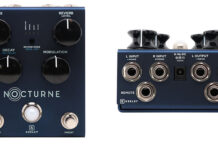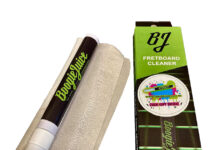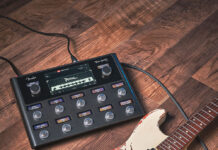On 'Era,' Mike Dawes Takes a Fingerstyle Journey, Literally and Figuratively
Several years ago, U.K.-based fingerstyle virtuoso Mike Dawes was visiting a lavatory at New York’s Blue Note, the venerable jazz club, when inspiration struck.
“I was there playing with the International Guitar Night tour and we had a tiny backstage area with a small tiled bathroom,” he says. “The reverb was so good in the bathroom that the initial groove just came out. The funny thing is that because it was so narrow, I couldn’t really move around the fretboard.”
The physical constraints imposed by playing guitar in that restroom would result in the single-note groove on “Overload,” from Dawes’ new solo album, Era. This sophomore effort is also informed by other places the globetrotting guitarist has known, such as Northern Ireland (“Fortress”), where he lived for several years, and the American Southwest (“Purr & Sway”), where he toured with the Moody Blues.
“The tunes are almost entirely inspired by travel,” Dawes says. “There are some obvious cultural influences present in the pieces, but largely the music is inspired by moments, be it a crowded city, a sleepless night in a hotel, welcoming friends in exotic countries, or a landscape. This record would not exist without my tours.”
Era has an uncannily natural sound to it, owing to the sophisticated ways in which Dawes’ guitar—a signature Andreas Cuntz CWG23s with Indian rosewood back and sides—was recorded. The instrument was captured with a pair of stereo microphones in the room, a large diaphragm condenser over the nut, a pair of condensers near the guitar’s body, and four onboard pickups. “I can’t speak highly enough of the engineer, Josh Clark, who really gets acoustic music,” Dawes said, adding that cheese-and-chutney sandwiches and tea between takes helped make for a relaxed vibe in the studio.
Though the sound of Dawes’ instrument on the record is predominantly acoustic—the guitarist uses extended techniques to call forth a wide range of timbral and percussive elements—it’s enhanced by a judicious use of effects. “I use lots of effects very moderately, enhancing the music whilst still letting the guitar breathe,” he says. “But who knows? Maybe my next album will be an Icelandic epic with gallons of reverb and delay.”
AXOLOGY
● GUITARS Andreas Cuntz CWG23s, Nick Benjamin Alpine spruce/cocobolo
● AMP DiMarzio Black Angel (both magnetic and piezo), K&K Trinity microphone, Schatten Dualie soundboard transducer
● EFFECTS Boss OC-3 Super Octave; Joyo JF-14 American Sound amp simulator, Strymon TimeLine delay effects, ZVEX Wah Probe
● STRINGS Ernie Ball Aluminum Bronze (.013–.056)
Source: www.guitarworld.com









